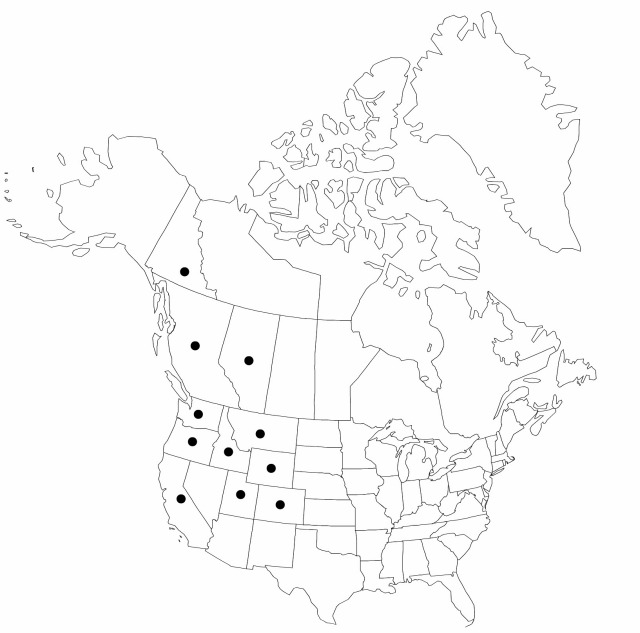Difference between revisions of "Carex scopulorum"
Amer. J. Sci. 164: 422, figs. 1–6. 1902.
FNA>Volume Importer |
RevisionBot (talk | contribs) m (Bot: Adding category Revised Since Print) |
||
| (7 intermediate revisions by 3 users not shown) | |||
| Line 6: | Line 6: | ||
|place=164: 422, figs. 1–6. 1902 | |place=164: 422, figs. 1–6. 1902 | ||
|year=1902 | |year=1902 | ||
| + | }} | ||
| + | |special_status={{Treatment/ID/Special_status | ||
| + | |code=F | ||
| + | |label=Illustrated | ||
| + | }}{{Treatment/ID/Special_status | ||
| + | |code=E | ||
| + | |label=Endemic | ||
}} | }} | ||
|basionyms= | |basionyms= | ||
| Line 19: | Line 26: | ||
-->{{Treatment/Body | -->{{Treatment/Body | ||
| − | |distribution= | + | |distribution=Alta.;B.C.;Yukon;Calif.;Colo.;Idaho;Mont.;Oreg.;Utah;Wash.;Wyo. |
|discussion=<p>Varieties 3 (3 in the flora).</p><!-- | |discussion=<p>Varieties 3 (3 in the flora).</p><!-- | ||
--><p><i>Carex scopulorum</i> is the common species of sect. Phacocystis in subalpine, seasonally wet meadows in the western mountains. It is replaced on the western slope of the Cascade range by <i>C. spectabilis</i>, a member of sect. Scitae. Where sympatric with <i>C. aquatilis</i>, <i>C. scopulorum</i> occurs in drier portions of the habitat.</p><!-- | --><p><i>Carex scopulorum</i> is the common species of sect. Phacocystis in subalpine, seasonally wet meadows in the western mountains. It is replaced on the western slope of the Cascade range by <i>C. spectabilis</i>, a member of sect. Scitae. Where sympatric with <i>C. aquatilis</i>, <i>C. scopulorum</i> occurs in drier portions of the habitat.</p><!-- | ||
| Line 53: | Line 60: | ||
-->{{#Taxon: | -->{{#Taxon: | ||
name=Carex scopulorum | name=Carex scopulorum | ||
| − | |||
|authority=T. Holm | |authority=T. Holm | ||
|rank=species | |rank=species | ||
| Line 60: | Line 66: | ||
|basionyms= | |basionyms= | ||
|family=Cyperaceae | |family=Cyperaceae | ||
| − | |distribution= | + | |distribution=Alta.;B.C.;Yukon;Calif.;Colo.;Idaho;Mont.;Oreg.;Utah;Wash.;Wyo. |
|reference=None | |reference=None | ||
|publication title=Amer. J. Sci. | |publication title=Amer. J. Sci. | ||
|publication year=1902 | |publication year=1902 | ||
| − | |special status= | + | |special status=Illustrated;Endemic |
| − | |source xml=https:// | + | |source xml=https://bitbucket.org/aafc-mbb/fna-data-curation/src/2e0870ddd59836b60bcf96646a41e87ea5a5943a/coarse_grained_fna_xml/V23/V23_714.xml |
|genus=Carex | |genus=Carex | ||
|section=Carex sect. Phacocystis | |section=Carex sect. Phacocystis | ||
| Line 71: | Line 77: | ||
}}<!-- | }}<!-- | ||
| − | -->[[Category:Treatment]][[Category:Carex sect. Phacocystis]] | + | --> |
| + | |||
| + | [[Category:Treatment]] | ||
| + | [[Category:Carex sect. Phacocystis]] | ||
| + | [[Category:Revised Since Print]] | ||
Latest revision as of 18:36, 6 November 2020
Plants not cespitose. Culms acutely angled, 10–90 cm, glabrous. Leaves: basal sheaths red-brown; sheath apex U-shaped; blades hypostomic, glabrous, 3–6 mm wide. Inflorescences: proximal bract shorter than inflorescence, 0.5–3 mm wide. Spikes erect; proximal 2–4 spikes pistillate, 1–2.5 cm × 3–5 mm, base cuneate; terminal 1–2 spikes staminate. Pistillate scales purple-brown, equaling perigynia, apex obtuse or acute, awnless. Perigynia ascending, pale brown with red-brown spots on apical 1/2, veinless, somewhat flattened, loosely enclosing achenes, ellipsoid or obovoid, 2–4 × 1.2–2.3 mm, dull, apex obtuse or acute, papillose; beak red-brown, 0.2–0.3 mm. Achenes not constricted, dull.
Distribution

Alta., B.C., Yukon, Calif., Colo., Idaho, Mont., Oreg., Utah, Wash., Wyo.
Discussion
Varieties 3 (3 in the flora).
Carex scopulorum is the common species of sect. Phacocystis in subalpine, seasonally wet meadows in the western mountains. It is replaced on the western slope of the Cascade range by C. spectabilis, a member of sect. Scitae. Where sympatric with C. aquatilis, C. scopulorum occurs in drier portions of the habitat.
Carex scopulorum is frequently confused with members of sect. Racemosae because of the similarity in habitat, size, inflorescence dimensions, and perigynium shape; it is distinguished by the two stigmas and flattened achenes. Carex scopulorum is probably most closely related to C. bigelowii, based on the similarity in vegetative morphology, hypostomic leaves, perigynia characteristics (absence of veins), and chromosome numbers.
Selected References
None.
Lower Taxa
Key
| 1 | Proximal sheaths brown, glabrous; culms glabrous on angles; perigynia obovoid. | Carex scopulorum var. scopulorum |
| 1 | Proximal sheaths red-brown, scabrous; culms scabrous on angles; perigynia ellipsoid to obovoid. | > 2 |
| 2 | Proximal sheaths with blades, fronts veinless; apex of perigynium obtuse or rounded. | Carex scopulorum var. bracteosa |
| 2 | Proximal sheaths bladeless, fronts with persistent veins; apex of perigynium acute. | Carex scopulorum var. prionophylla |